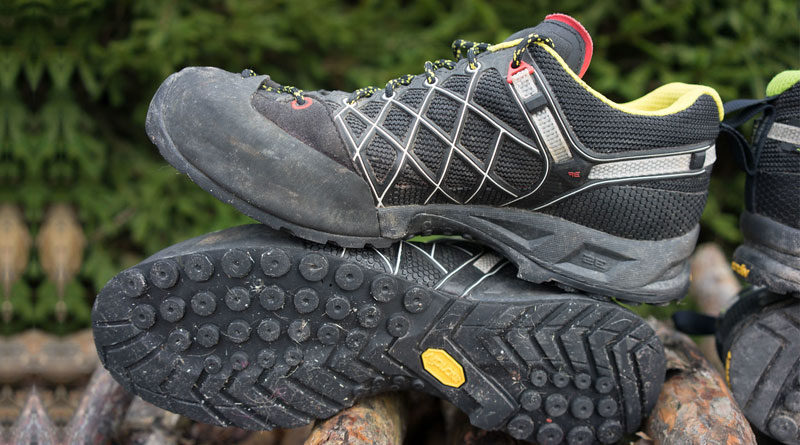What Are Approach Shoes Used For?
Approach shoes are specialized footwear for technical hiking and climbing. They are typically used for approaches to rock climbs where the terrain is rugged and uneven, necessitating a combination of hiking and scrambling.
Approach shoes are similar to hiking or trail running shoes, but they have additional features and benefits that make them appropriate for climbing approaches. They usually have sticky rubber soles that provide excellent traction on rock surfaces, as well as a sturdy construction that can withstand the rigors of rough terrain.
Some approach shoes are also low-cut, allowing for greater ankle flexibility and mobility, making them ideal for scrambling over boulders and other obstacles. A toe rand, which is a rubber strip that protects the toe area from abrasion and impact, may also be present.
Features
Approach shoes are a unique type of footwear that is designed to be used for technical hiking and climbing. These shoes have several features that make them ideal for this type of activity.
Sticky rubber soles for excellent traction
One of the most important features of approach shoes is their sticky rubber soles, which provide excellent traction on rock surfaces. This feature is critical for climbers who need to be able to grip onto surfaces as they make their way towards the base of a climb.
Durable construction for rugged terrain
Another advantage of approach shoes is their tough construction, which makes them ideal for rough terrain. They are built to withstand the rigors of rough terrain, such as sharp rocks, uneven surfaces, and exposure to the elements. This durability is essential for outdoor enthusiasts who rely on their footwear to keep them safe in adverse conditions.
Low-cut design for ankle flexibility and mobility
Approach shoes are typically designed with a low-cut design that allows for greater ankle flexibility and mobility. Climbers who need to move quickly and easily over boulders and other obstacles will appreciate this feature. Approach shoes’ low-cut design allows for more freedom of movement, which can help climbers navigate difficult terrain more effectively.
Toe rand for protection from abrasion and impact
Approach shoes often feature a toe rand, which is a rubber strip that protects the toe area from abrasion and impact. This feature is important for climbers who need to protect their feet from the rough surfaces that they encounter during their climbs. The toe rand can help to prevent injuries and keep climbers comfortable and safe during their approach to a climb.
Uses of Approach Shoes
Approach shoes are versatile footwear that can be used in a variety of outdoor activities.
Approaches to rock climbs
One of the primary uses of approach shoes is for approaches to rock climbs. Climbing approaches often involve scrambling over rough terrain, and approach shoes are specifically designed to provide the traction and stability needed for this type of activity. The sticky rubber soles of approach shoes help to grip onto rock surfaces, making it easier for climbers to navigate challenging terrain.
Scrambling over boulders and other obstacles
Approach shoes are also commonly used for scrambling over boulders and other obstacles. They are ideal for scrambling over rocks and other natural features, which many outdoor enthusiasts enjoy. Approach shoes’ low-cut design allows for greater ankle mobility, making it easier to navigate uneven surfaces. Approach shoes’ tough construction also protects against abrasion and impact, which is useful when scrambling over rough terrain.
Hiking on technical terrain
Approach shoes are also suitable for hiking on technical terrain. Many hiking trails involve uneven terrain and rocky surfaces, and approach shoes can provide the traction and stability needed to navigate these types of trails safely. The sticky rubber soles of approach shoes help to grip onto surfaces, and the durable construction provides protection from rocks and other obstacles.
Benefits
Approach shoes offer several benefits that make them a superior choice for certain outdoor activities compared to regular hiking shoes.
Better traction and stability on rock surfaces
One of the primary benefits of approach shoes is their better traction and stability on rock surfaces. These shoes are specifically designed with sticky rubber soles that provide excellent grip on a variety of surfaces, including rock. This feature is especially important for climbers who need to navigate technical approaches and rough terrain to reach a climb. With approach shoes, climbers can move more confidently and safely over challenging terrain.
More durable and protective than regular hiking shoes
Another advantage of approach shoes is their long-lasting durability and protective design. These shoes are built to withstand the rigors of rugged terrain, which may include sharp rocks, uneven terrain, and exposure to the elements. Approach shoes are typically more protective than regular hiking shoes, with features like toe rands and thicker soles that provide more abrasion and impact protection. This makes them an excellent choice for outdoor enthusiasts looking for long-lasting and protective footwear for their adventures.
Greater ankle mobility for scrambling and climbing
Approach shoes offer greater ankle mobility, which is important for scrambling and climbing. The low-cut design of approach shoes allows for greater freedom of movement and flexibility, which makes it easier to navigate over boulders and other obstacles. This feature is especially important for climbers who need to be able to move quickly and easily over rough terrain to reach their climb.
Considerations when Choosing Approach Shoes
Choosing the right approach shoes can greatly enhance your outdoor experience. When selecting approach shoes, there are several factors to consider to ensure the best fit, comfort, and performance.
Fit and comfort
Fit and comfort are essential considerations. Approach shoes need to fit snugly but not too tight. A good fit will provide support and prevent blisters, while also allowing enough room for natural foot movement. Some people prefer a slightly larger size for added comfort or to accommodate thicker socks. It’s important to try on several brands and models to find the best fit for your feet.
Sole composition and stiffness
Sole composition and stiffness are also crucial factors to consider. The type of rubber used in the sole will affect its durability and grip. A stickier rubber provides better traction on rock surfaces, while a harder rubber sole will last longer. Additionally, the stiffness of the sole will affect the shoe’s ability to edge and smear. A stiffer sole is better for technical climbs, while a more flexible sole is better for hiking or scrambling over boulders.
Breathability and waterproofing
Breathability and waterproofing are important factors to consider depending on your intended use. If you are hiking in hot, dry conditions, you may want to prioritize breathability to keep your feet cool and dry. On the other hand, if you are hiking in wet or muddy conditions, waterproofing is important to keep your feet dry and comfortable.
Conclusion
In conclusion, approach shoes are a specialized type of footwear designed for technical approaches and challenging terrain. They provide several benefits, such as better traction, greater durability, and improved ankle mobility. When choosing approach shoes, it’s important to consider factors such as fit, sole composition and stiffness, and breathability and waterproofing. By selecting the right approach shoes, you can enhance your outdoor experience and tackle technical terrain safely and comfortably.
Approach shoes are an essential piece of gear for climbers, hikers, and outdoor enthusiasts who want to explore rugged terrain while remaining safe. Approach shoes provide the support, protection, and flexibility required to navigate technical terrain with ease, thanks to their sticky rubber soles, durable construction, and a low-cut design. Consider your specific needs and intended use when selecting approach shoes to find the best fit and performance. You can enjoy the outdoors with confidence and comfort if you wear the right approach shoes.




